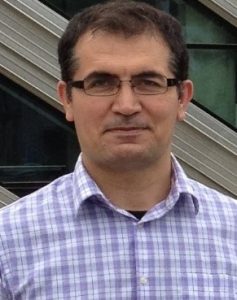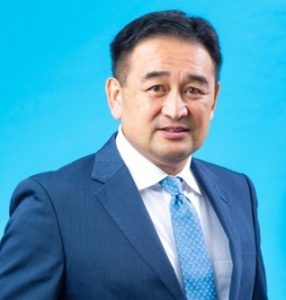
Prof. Cecilia Mascolo
University of Cambridge
Title: Sounding out audio data and wearable systems for health diagnostics
Bio:
Cecilia Mascolo is the mother of a teenage daughter but also a Full Professor of Mobile Systems in the Department of Computer Science and Technology, University of Cambridge, UK. She is co-director of the Centre for Mobile, Wearable System and Augmented Intelligence and Deputy Head of Department for Research. She is also a Fellow of Jesus College Cambridge and the recipient of an ERC Advanced Research Grant. Prior joining Cambridge in 2008, she was a faculty member in the Department of Computer Science at University College London. She holds a PhD from the University of Bologna. Her research interests are in mobile systems and data for health, human mobility modelling, sensor systems and networking and mobile data analysis. She has published in a number of top tier conferences and journals in the area and her investigator experience spans projects funded by Research Councils and industry. She has received numerous best paper awards and in 2016 was listed in “10 Women in Networking /Communications You Should Know”. She has served as steering, organizing and programe committee member of mobile, sensor systems, networking, data science conferences and workshops. She has delivered a number of keynote talks at conferences and workshops in the area of mobility, data science, pervasive computing and systems.
 Prof. Konstantina Nikita
Prof. Konstantina Nikita
School of Electrical and Computer Engineering, National Technical University of Athens
Title: Multimodal data fusion and AI towards personalized diabetes care
Bio:
Konstantina Nikita, M.D., Ph.D., is a full Professor at the School of Electrical and Computer Engineering, National Technical University of Athens. She is director of the Mobile Radiocommunications Laboratory and founder and director of the Biomedical Simulations and Imaging (BIOSIM) Laboratory. Since 2015, she is Irene McCulloch Distinguished Adjunct Professor of Biomedical Engineering and Medicine at Keck School of Medicine and Viterbi School of Engineering, University of Southern California. She has been the technical manager of 60 European and National R&D projects on fundamental research and practical applications. She is the Editor-in-Chief of the IEEE Open Journal of Antennas and Propagation and a member of the Editorial Board of the IEEE Transactions on Biomedical Engineering, IEEE Journal of Biomedical and Health Informatics, IEEE Transactions on Antennas and Propagation. She has been Chair of the program/organizing committee of more than 50 international conferences and has served as keynote speaker at several international conferences and symposia. She has been the advisor of 28 completed Ph.D. theses, several of which have received various awards. She is a Fellow of the Institute of Electrical and Electronics Engineers (IEEE), a Founding Fellow of the European Association of Medical and Biological Engineering and Science (EAMBES), and a Fellow of the American Institute of Medical and Biological Engineering (AIMBE). She serves as chair of the LS7 Consolidator Grant Panel of the European Research Council (ERC), for granting investigator-driven frontier research in the domain of life sciences. She has published 200 journal articles and 350 conference proceedings papers, is the author or editor of 12 books, and holds several patents for her discoveries. She has received various awards, among which the Bodossakis Foundation Academic Prize (2003) for exceptional achievements in “Theory and Applications of Information Technology in Medicine”.
Abstract:
Intelligent personal health systems leverage advances in wireless, wearable, and ambient technologies, coupled with advanced data analytics and simulation techniques, in order to optimize treatment and facilitate effective self-disease management. The integration of heterogeneous data sources with existing pathophysiological knowledge and disease models in these systems can fuel informed, accurate diagnosis, timely prognosis, and tailored interventions, underpinning precision medicine. In this keynote, we will discuss advanced integrated technology-aided approaches towards the development of personal health systems for chronic disease management, focusing on Diabetes Mellitus and Obesity. Approaches for the enhanced integration of multidimensional, heterogeneous data will be outlined while emerging disease modelling approaches will be presented, including advanced statistics and explainable Artificial Intelligence. The keynote will also highlight advanced clinical decision-making and recommendation techniques that are deployed towards the generation of personalized recommendations with the ultimate goal to enhance clinical and well-being outcomes.
 Assoc. Prof. Mehmet Rasit Yuce
Assoc. Prof. Mehmet Rasit Yuce
Monash University, Australia
Title: Cuffless Blood Pressure Monitoring using Wearable Body Sensors
Bio:
Mehmet Rasit Yuce is an associate professor in the Department of Electrical and Computer Systems Engineering, Monash University, Australia. He received the M.S. degree in Electrical and Computer Engineering from the University of Florida, Gainesville, Florida in 2001, and the Ph.D. degree in Electrical and Computer Engineering from North Carolina State University (NCSU), Raleigh, NC in December 2004. He was an academic member in the School of Electrical Engineering and Computer Science, University of Newcastle, New South Wales, Australia until Jul 2011. In July 2011, he joined Monash University. In 2014, he received the prestigious Australian Research Council Future Fellowship.
His research interests include wearable devices, Internet-of-Things (IoT) for healthcare, cuffless blood pressure monitoring devices. wireless implantable telemetry, wireless body area network (WBAN), bio-sensors, integrated circuit technology dealing with digital, analog and radio frequency circuit designs for wireless, biomedical, and RF applications. Dr. Yuce has published more than 200 technical articles in the above areas and received a NASA group achievement award in 2007 for developing an SOI transceiver. He received a best journal paper award in 2014 from the IEEE Microwave Theory and Techniques Society (MTTS). He received a research excellence award in the Faculty of Engineering and Built Environment, University of Newcastle in 2010. He is an author of the books: Wireless Body Area Networks published in 2011, Ultra-Wideband and 60 GHz Communications for Biomedical Applications published in 2013 and Internet of Things (IoT): Systems and Applications published in 2019. He is a topical editor for IEEE Sensors Journal, an editor-in-chief for Sensors, and a guest editor for several IEEE Journals each year.
Abstract:
Blood pressure (BP) is one of the most important parameters in diagnosing and treating cardiovascular diseases (CVD). It is thus important to monitor blood pressure continuously. At the moment blood pressure is monitored and measured with an inflatable cuff placed around a person’s arm with a sample every 20-30 minutes. Each time it should be inflated for the device to read values, which is very inconvenient and cumbersome, and can be painful.
In this talk, we will discuss the methods of estimating BP without a cuff. Several body sensors can be used to calculate Pulse Transit Time (PTT) or Pulse Arrival Time (PAT), which is related to pulse wave velocity (PWV). A pressure is generated with the aortic valve opening that propagates through the entire arterial tree. Wearable body sensor devices can be used to measure PTT and PAT, which are then used for estimation of BP.
The talk will present PAT/PTT estimation using several body sensors including optical (photoplethsmographic-PPG) sensor, pressure sensors, bio-impedance, and electrocardiogram (ECG). And recently we used continuous wave radar to estimate blood pressure. The talk will cover the development of such wearable body sensors and discuss how they can be used to obtain pulse wave, PTT/PAT, and BP estimation.
 Prof. Wen Jung LI
Prof. Wen Jung LI
City University of Hong Kong
Title: Applying AI Sensors to TCM Diagnostics – Conformable 3D and Skin-like Sensors as New Biometric Tools for Human Physiological Monitoring
Bio:
Wen Jung LI (BS/MS, University of Southern California; PhD, UCLA) is currently Chair Professor of Biomedical Engineering in the Dept. of Mechanical Engineering and concurrently serving as Associate Provost (Resources Planning) of the City University of Hong Kong (CityU). Prior to joining CityU, he was with the Dept. of Mechanical and Automation Engineering of The Chinese University of Hong Kong (CUHK) from 1997 to 2011. His academic honors include IEEE Fellow, ASME Fellow, and 100 Talents of the Chinese Academy of Sciences. He served as the President of the IEEE Nanotechnology Council in 2016 and 2017 and is currently the Editor-in-Chief of the IEEE Open Journal on Nanotechnology. Before joining CUHK, he held R&D positions at the NASA/Caltech Jet Propulsion Laboratory (Pasadena, CA), The Aerospace Corporation (El Segundo, CA), and at Silicon Microstructures Inc. (Fremont, CA). Since 1997, his research group has published more than 350 technical papers related to MEMS, Nano-sensors, and Robotics, including papers in Science Advances, Nature Communications, Nature Methods, Advanced Functional Materials, IEEE/ASME J. MEMS, and IEEE Internet of Things Journal. His former students have founded AI sensor companies such as Sengital (HK), BWSensing (Wuxi), and AI Motion (HK/Shenzhen), which are producing products for applications in digital health, IoT, and sports education. His current research interest includes BioMEMS, super-resolution microscopy, and intelligent cyber physical sensors.
Abstract:
Without conventional Western medicine diagnostic tools such as stethoscope, electrocardiogram, magnetic resonance imaging, X-ray computed tomography, etc., Traditional Chinese Medicine (TCM) relies on visual inspection, auscultation/olfaction, inquiring, and palpation for medical diagnosis. For example, sphygmopalpation at specific locations of human wrists has been used as a medical diagnostic technique in China since the Han Dynasty (202 BC – 220 AD), and it is now generally accepted that TCM practitioners are able to decipher 28 types of basic pulse patterns using their fingertips. This TCM sphygmopalpation technique has gained tremendous popularity recently as a low-cost and non-invasive diagnostic technique for tracking patient health status. In this lecture, we will present two examples of our recent work in using 3D-additive-printing technology to develop flexible skin-like and 3D contour-conforming sensors for digitalizing physiological signals based on TCM diagnostic concepts. First, a skin-like flexible patch of arterial pulse sensing array (16×16 elements) for acquiring 3D arterial pulse signals will be discussed. Using an artificial neural network to analyze the 3D pulse data, we have proven that some pulse patters described by TCM practitioners are consistent and repeatable among different test subjects. Second, a personalized 3D contour-conforming device for real-time auricular electric skin impedance (AESI) monitoring of multiple (13) points across entire ear auricle will be presented. This device enabled the acquisition of 3D spatiotemporal mapping of AESI, which was shown to be unique among individuals, but which was also shown to vary consistently when the individuals performed similar sequence of exercises.

Assoc. Prof. Chun Tung Chou
School of Computer Science and Engineering, the University of New South Wales, Australia
Title: Molecular circuits for Communications and Signal Processing as Enabler of Internet of BioNano Things
Bio:
Chun Tung Chou is an Associate Professor at the School of Computer Science and Engineering, the University of New South Wales, Australia. He received the BA degree in Engineering Science from the University of Oxford, UK and the PhD degree in Control Engineering from the University of Cambridge, UK. He is/was on the editorial board of IEEE Transactions on Molecular, Biological, and Multi-Scale Communications; IEEE Wireless Communications Letters; Nano Communication Networks; and, Frontiers in Communications and Networks. His research interests are in molecular communications, molecular computing and pervasive computing.
Abstract:
The Internet of Things (IoT) paradigm will create a rich ecosystem of physical devices that will be connected to the Internet. The current IoT devices are based on electronic processing and radio communications that use electronic circuits for information processing. These electronic circuits are built from the interconnection of modules (or smaller electronic circuits) that perform logical operations, computation, sensing etc. This modular architecture enables the scalability and flexibility that drive the success of electronic information processing. However, the electronic material is only one of the many physical substrates that can be used for information processing. A notable alternative is the use of chemical reactions by living cells to perform computations. These computations, which are performed over a chemical substrate, enable cells to sense the environment, make decisions, communicate with other cells and do many other amazing things. If we are able to create devices that can use this chemical computation substrate, then we can enable applications such as in-body monitoring, cell based therapy etc. These devices will form the basis of the Internet of BioNano Things (IoBNT). At the same time, these devices are also of great interests to and have been investigated by researchers in synthetic biology, biomedical engineering etc. Given the success of IoT, one may ask what success factors in electronic information processing can be used to drive the creation of IoBNT devices. We believe an important step is to create a counterpart of electronic circuits for IoBNT, which we will refer to as molecular circuits. A molecular circuit, which essentially is composed of a set of chemical reactions, will perform a modular task such as detecting whether the concentration of a target chemical is above a threshold level, decoding the signals that are sent from another IoBNT device etc. We believe the realisation of these molecular modules and their interconnections will create a rich ecosystem of IoBNT devices. In this talk, we will describe our work in designing molecular circuits for communication and signal processing tasks. We will describe molecular circuits that can perform demodulation, detect concentration level or detect persistent signals. All these circuits are built on a common theoretical framework based on continuous-time Markov chain and statistical detection theory.


